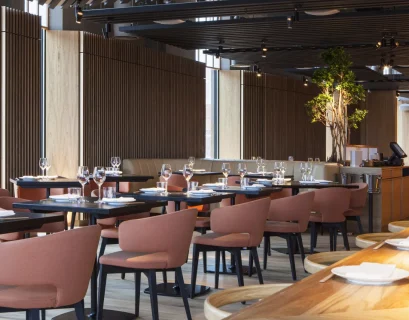The main door of a property serves as both a first impression and a primary security feature. Beyond aesthetics, main doors provide privacy, protection, and insulation, playing a pivotal role in the home’s design and functionality. Whether for residential, commercial, or industrial use, choosing the right main door involves considering materials, design, durability, and the door’s ability to withstand various environmental conditions. Here’s an in-depth look at the types of main doors, material options, and factors to consider for a secure, stylish, and durable entrance.
1. Importance of the Main Door in Home Design
Main doors are more than just a means to enter a home—they embody the character and architectural style of the building. They:
- Create First Impressions: An appealing main door can enhance a property’s curb appeal and set the tone for the interior.
- Provide Security: High-quality doors with secure locking mechanisms deter unauthorized entry, ensuring occupants feel safe.
- Offer Energy Efficiency: Well-constructed doors provide insulation, helping regulate indoor temperature and reduce energy costs.
- Enhance Privacy: Properly designed main doors maintain privacy by shielding interiors from prying eyes and reducing noise infiltration.
2. Types of Main Doors
Main doors are available in various types, each offering unique benefits and suited for different settings and preferences.
A. Single Main Doors
Single doors are a popular choice for smaller spaces or homes with a modern aesthetic. They offer a minimalist look while still providing ample security and style.
- Pros: Compact and simple, suitable for standard entrances.
- Cons: Limited entry width, may not accommodate large furniture moving.
B. Double Main Doors
Double doors offer a grand, welcoming entrance, often found in luxury homes or estates. They add symmetry and balance, making them a popular choice for larger homes.
- Pros: Creates a larger opening, ideal for grand entrances.
- Cons: Requires more space, may need additional structural support.
C. Sliding Main Doors
Sliding doors add a contemporary look and save space by not swinging open. They are often used in commercial buildings or as main entrances to outdoor spaces.
- Pros: Space-saving, sleek, and modern appearance.
- Cons: Less secure than traditional doors, limited insulation if not double-glazed.
D. Pivot Doors
Pivot doors are a statement piece in modern homes, rotating on a central hinge rather than swinging open. They are ideal for properties looking to make a bold design choice.
- Pros: Visually impressive, unique, and space-efficient.
- Cons: Requires special hardware, may be harder to install.
3. Material Choices for Main Doors
The choice of material for a main door significantly affects its durability, security, and aesthetic. Here are some popular materials:
A. Wood
Wood is a classic choice that offers warmth, strength, and natural beauty. Available in various types, including mahogany, oak, and teak, wood can be customized with intricate designs and finishes.
- Pros: Versatile, elegant, and easy to customize.
- Cons: Prone to warping if not properly treated, requires maintenance.
B. Steel
Steel doors provide exceptional security and durability, making them a popular choice for high-security settings or industrial properties.
- Pros: Strong, highly secure, and weather-resistant.
- Cons: Limited design options, can dent or rust if not maintained.
C. Fiberglass
Fiberglass doors are becoming increasingly popular due to their durability, low maintenance, and wide range of finishes that mimic natural wood.
- Pros: Durable, low-maintenance, and energy-efficient.
- Cons: Can be expensive, limited customization.
D. Aluminum
Aluminum doors are lightweight, corrosion-resistant, and suitable for modern architectural styles. They are often paired with glass for a sleek, contemporary look.
- Pros: Lightweight, corrosion-resistant, and versatile.
- Cons: Limited insulation, more suitable for warm climates.
E. Glass
Glass doors add a modern aesthetic and bring natural light into the interior. Often reinforced or combined with metal or wood frames, they work well for both residential and commercial entrances.
- Pros: Stylish, enhances natural lighting, available in various finishes.
- Cons: Limited privacy and security, more maintenance required.
4. Key Features to Consider When Choosing a Main Door
Selecting the right main door involves balancing aesthetic appeal with practical considerations. Here are essential features to look out for:
A. Security Features
A main door should come with high-quality locks, such as deadbolts, multipoint locking systems, and, for commercial buildings, smart locks or biometric options.
B. Energy Efficiency
Energy-efficient doors, particularly those with insulation and thermal break features, help reduce heating and cooling costs. Look for doors with energy ratings or double glazing for better insulation.
C. Style and Design
The style of the main door should align with the property’s architectural design. Options range from modern minimalist to rustic or traditional styles, with endless customization available in colors, textures, and finishes.
D. Durability and Maintenance
Consider the durability of the door material based on environmental conditions. For example, wood may require regular sealing in humid climates, while fiberglass and steel offer high durability with minimal maintenance.
E. Soundproofing
For homes in noisy areas, soundproofing is essential. Thicker doors, insulated cores, and tight seals help reduce noise infiltration, ensuring a quieter interior.
5. Customization Options for Main Doors
Customization adds a personal touch and enhances the functionality of main doors. Many manufacturers offer the following options:
- Color and Finish: Customize the door with finishes that complement the home’s color palette.
- Glass Panels: Add glass inserts or sidelights for a modern look while allowing natural light to enter.
- Decorative Hardware: Opt for handles, locks, and hinges that enhance the door’s aesthetic appeal.
- Weatherstripping and Insulation: High-quality weatherstripping keeps drafts out and enhances energy efficiency.
6. Maintenance Tips for Main Doors
To maintain the appearance and functionality of your main door, regular maintenance is essential:
- Wood Doors: Seal every few years to protect against moisture, and clean periodically to prevent mold or mildew.
- Metal Doors: Apply a protective coating to prevent rust, especially in humid climates.
- Glass Doors: Clean regularly with glass cleaner to maintain clarity and avoid scratches.
- Fiberglass Doors: Minimal maintenance required; periodic cleaning and inspection for any wear are sufficient.
Conclusion
The main door is a crucial element in any property, blending security with aesthetic appeal. By carefully selecting the type, material, and style of the door, homeowners and business owners alike can enhance curb appeal, improve energy efficiency, and increase security. With options ranging from traditional wooden doors to modern pivot doors, finding a reliable manufacturer or supplier with quality materials and customization options can make all the difference in achieving the perfect entrance.











